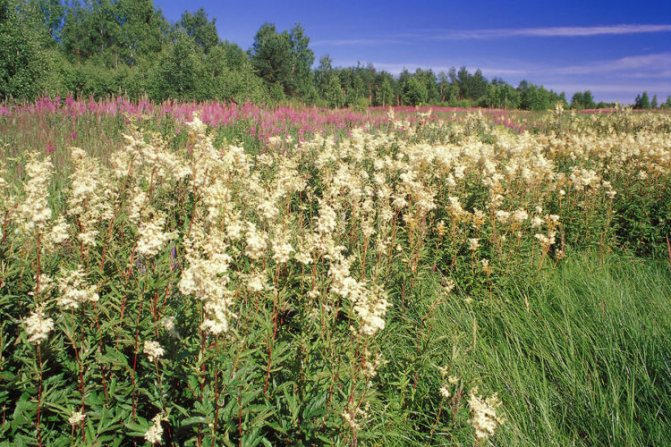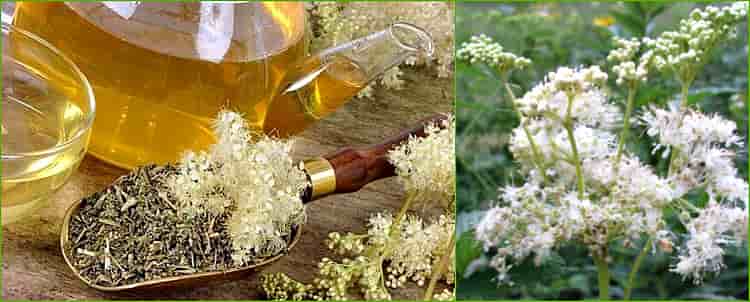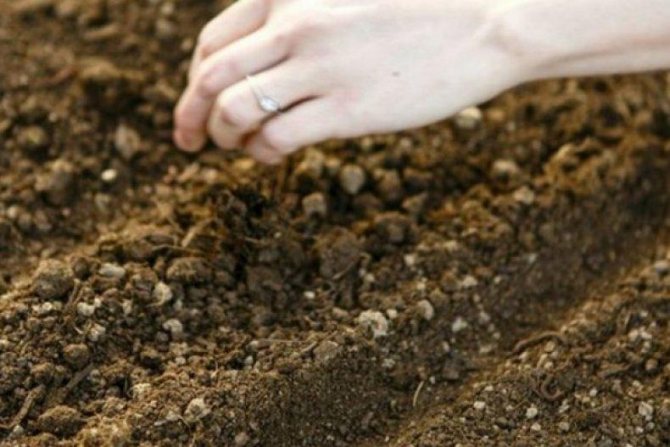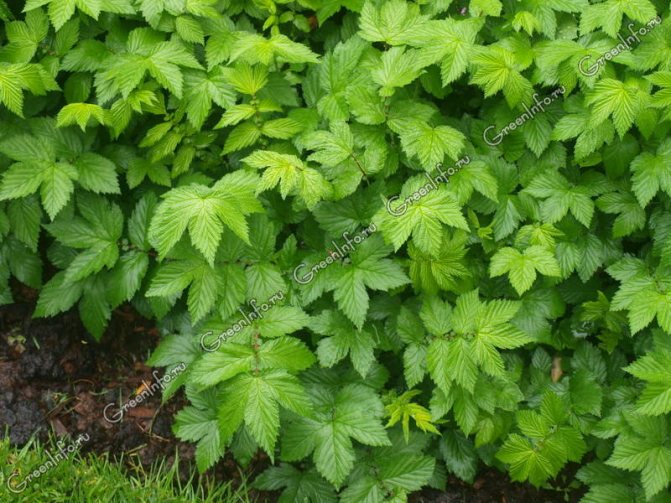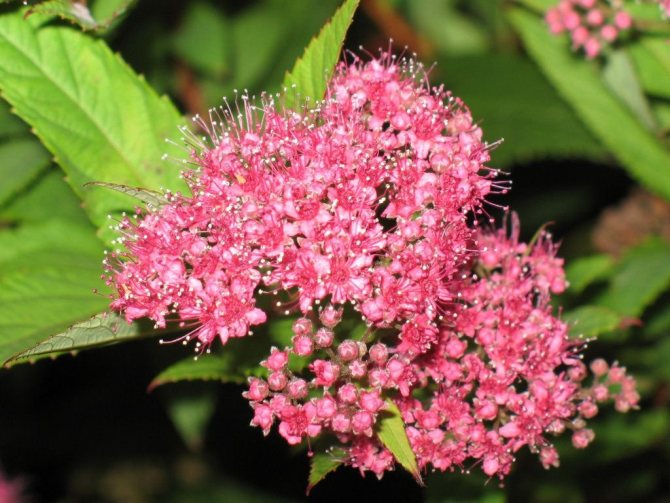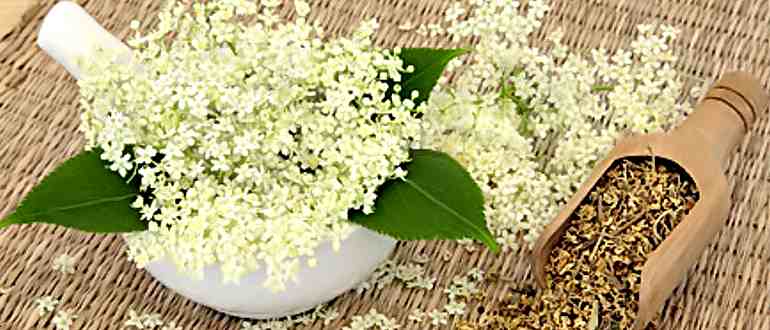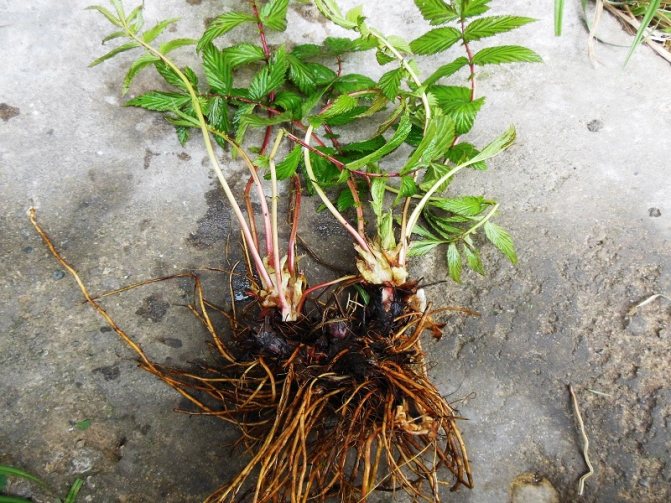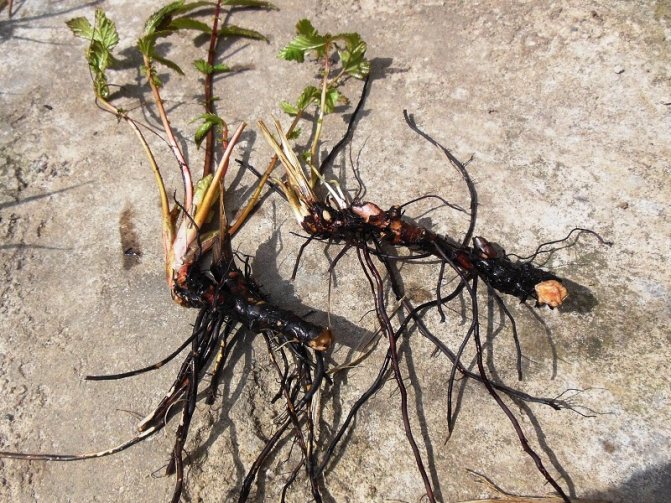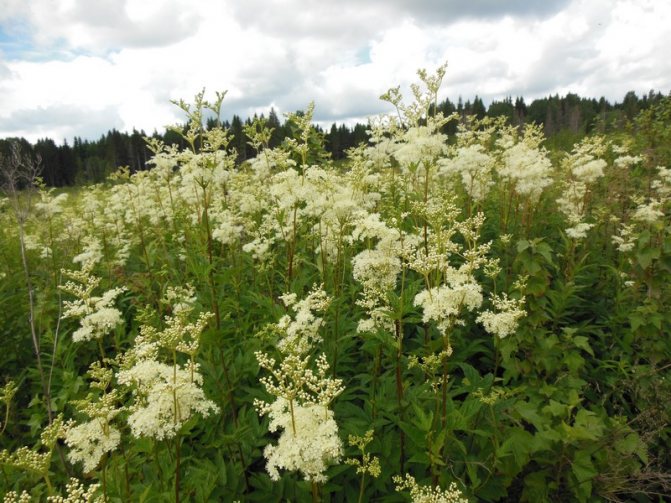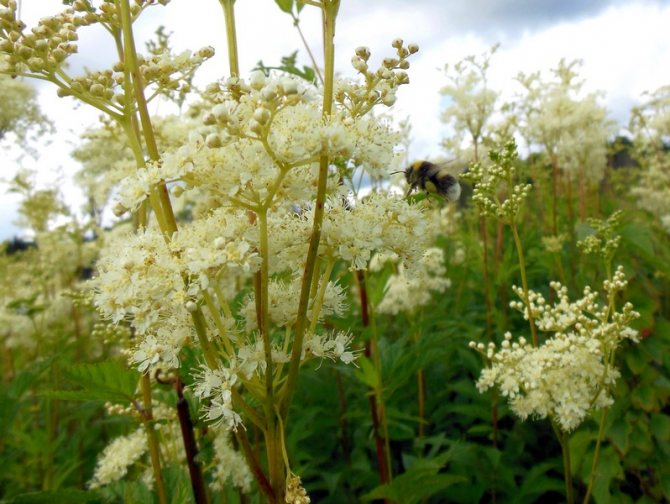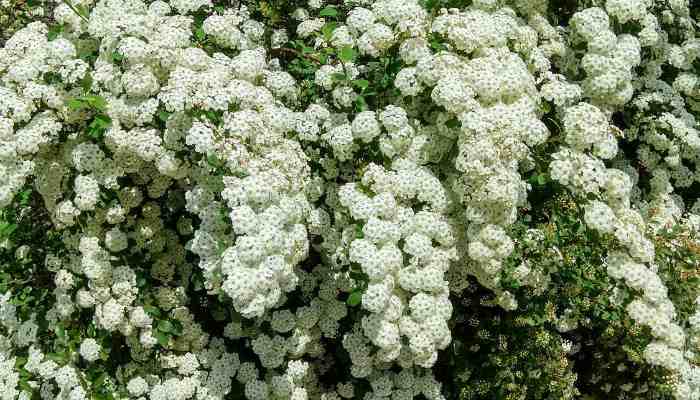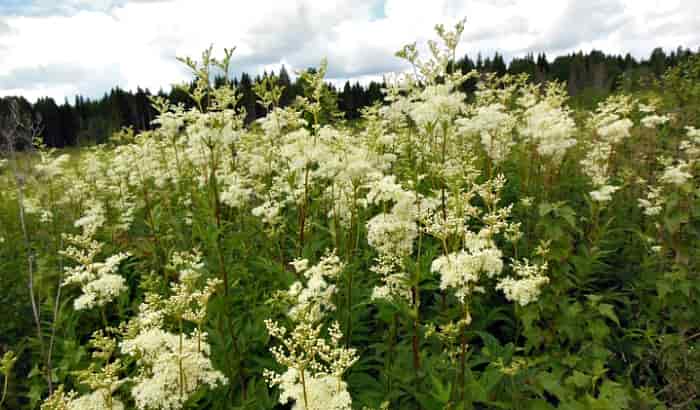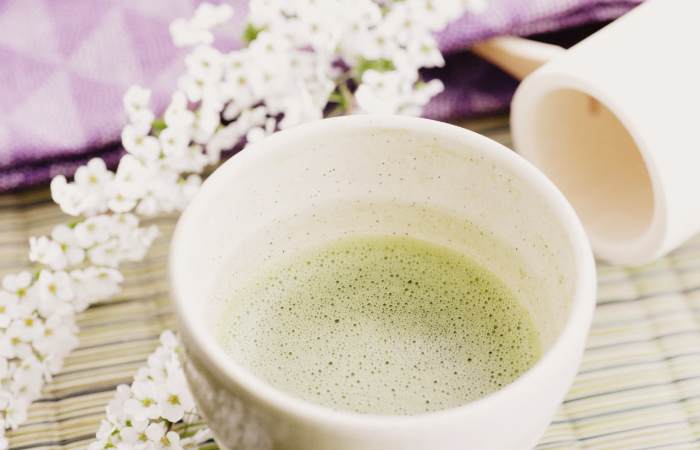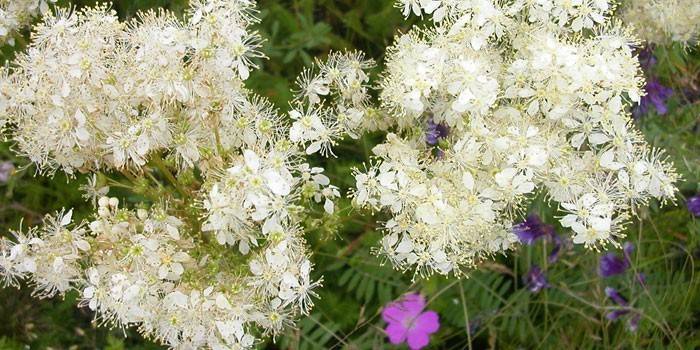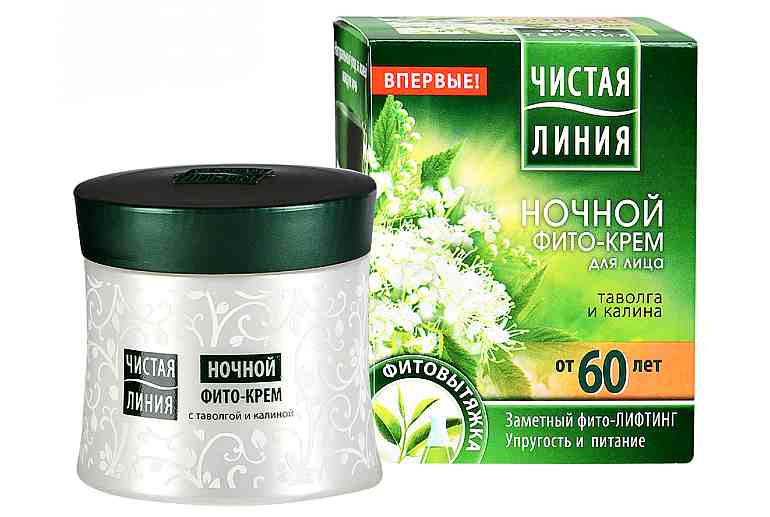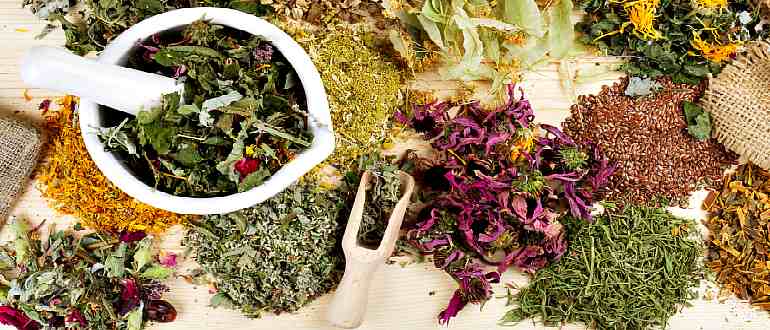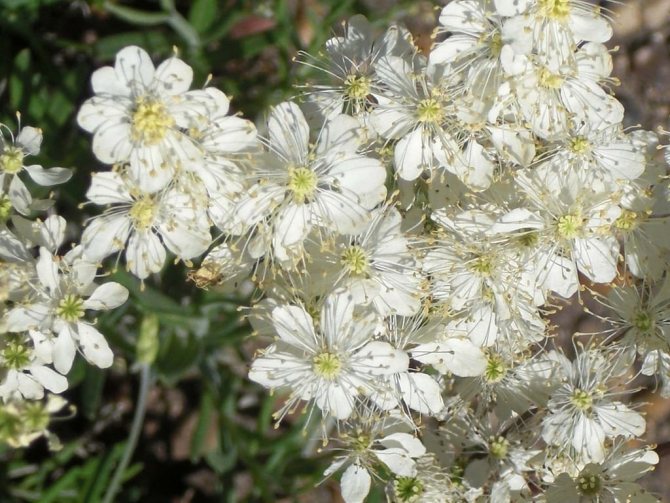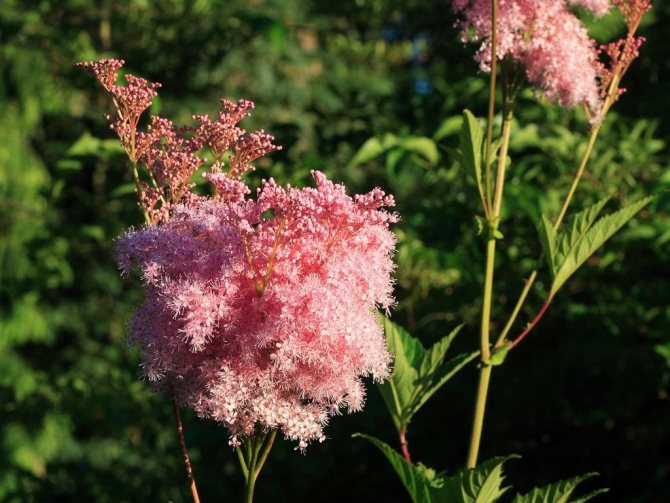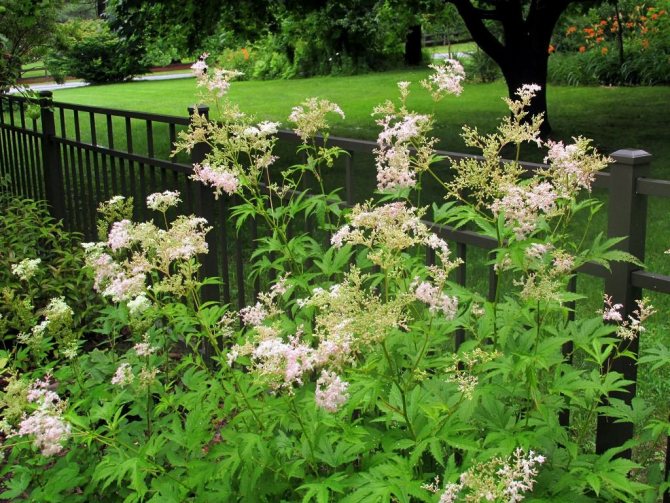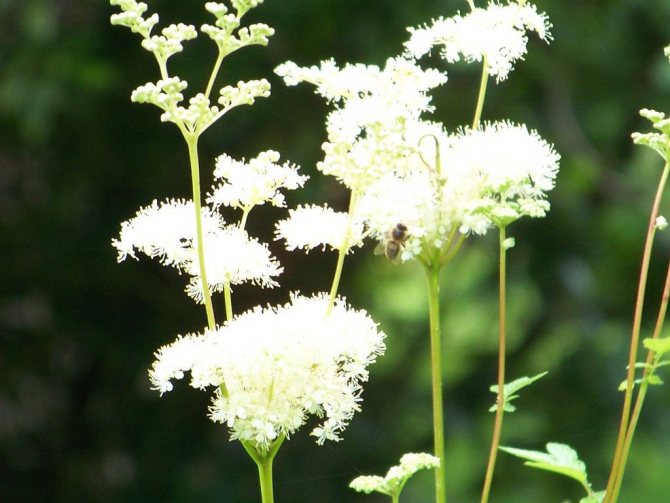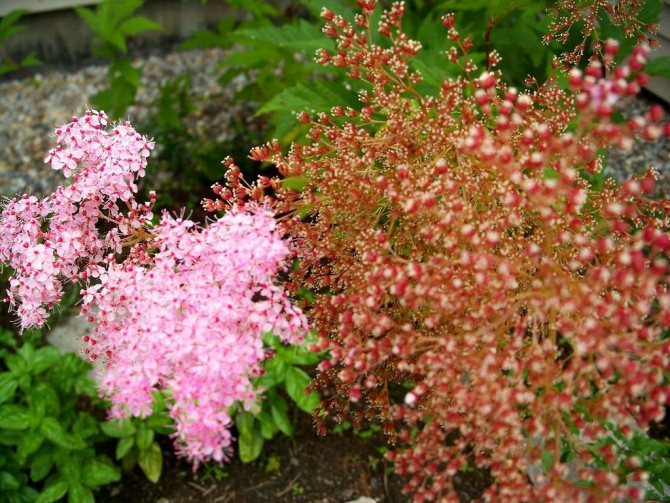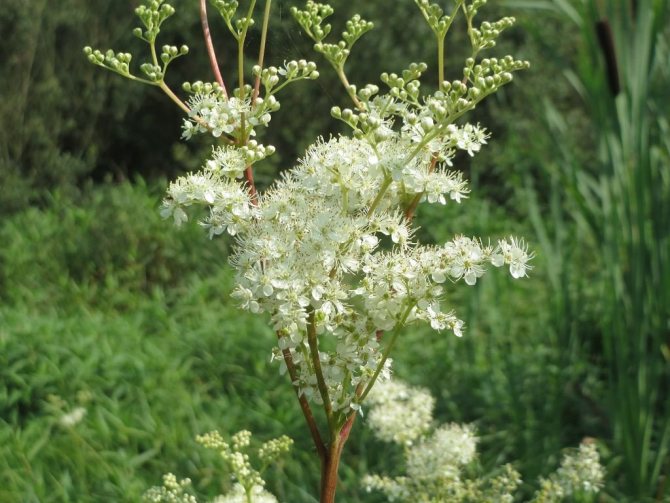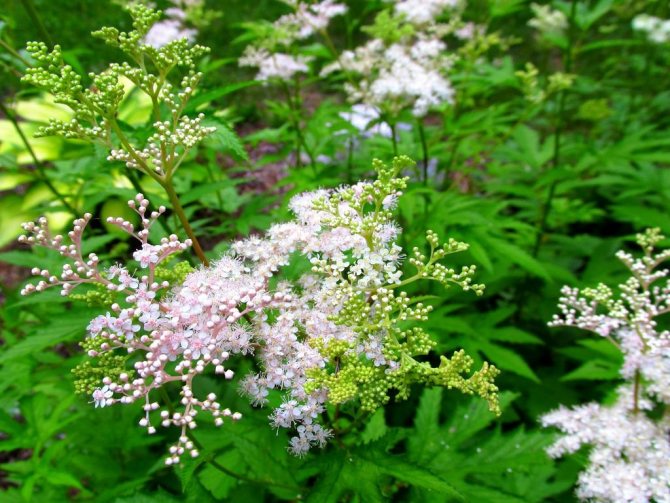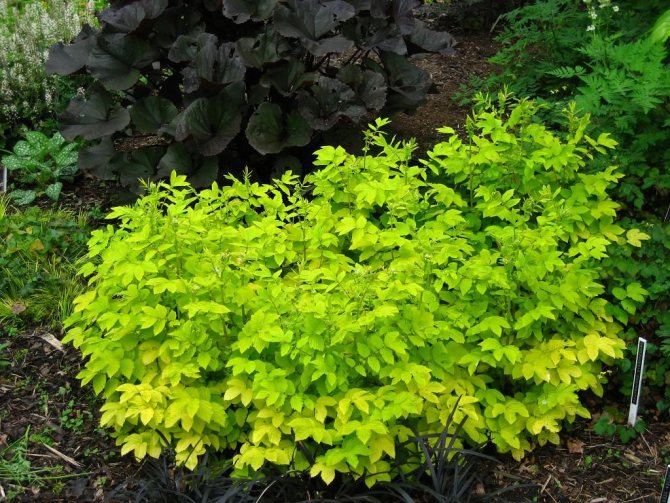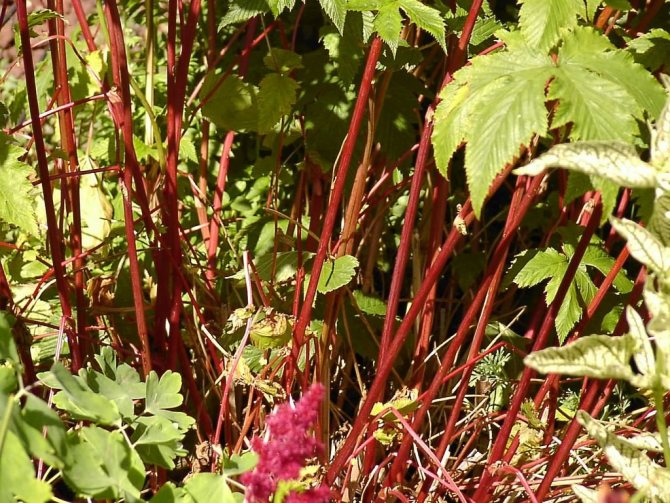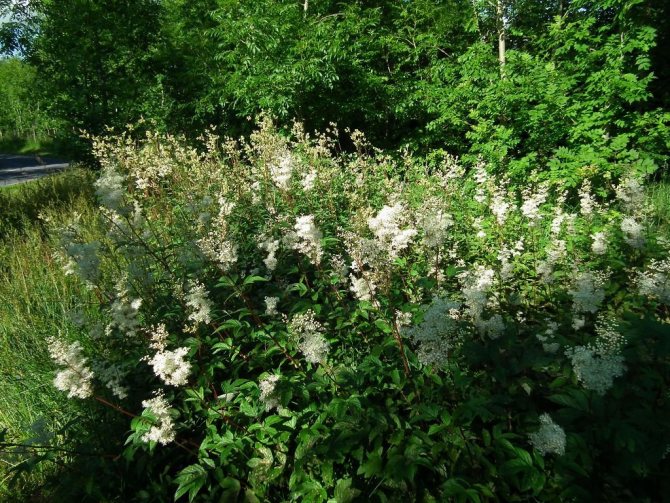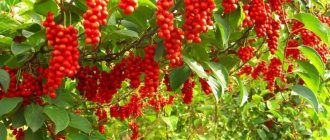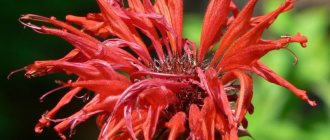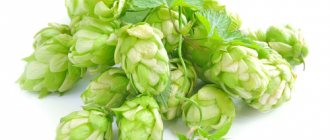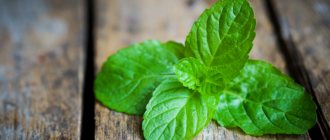Where does the grass meadowsweet grow and what does it look like, common meadowsweet, common meadowsweet: photo
Elm grass grows in meadows and shaded forests. Prefers neutral or alkaline soil. The French called the meadowsweet - the queen of the meadow. If you see her live, you will understand why.
The grass has a tall, hard stem, dense, green leaves, beautiful flowers with a honey smell. Many people like to use meadowsweet for decorating rooms and premises. A pleasant, rich aroma of honey cake (as the plant is called according to the folk) retains a very long time. In addition, the meadowsweet is a very beautiful plant.

What does the medicinal meadowsweet look like?
Reproduction methods
The meadowsweet is propagated by seed and vegetative methods. Seeds are usually sown directly into open ground. The landing site is chosen in partial shade. The seeds are sown in the middle of autumn, in winter they undergo natural stratification, and in the spring the first non-squeeze shoots appear. In order not to confuse them with weeds, they make markings. The soil must be regularly moistened. The flowering of seedlings begins from the second year of life.
The meadowsweet constantly produces lateral shoots and root shoots, so vegetative reproduction is much easier. It should also be borne in mind that it is this method that allows you to preserve the varietal characteristics of ornamental plants. Cuttings are cut in July-August from young annual shoots. Each should contain 5-6 leaves. The leaf at the bottom cut is removed along with the petiole, the remaining leaf plates are cut in half. The lower cut is treated with a growth stimulant for several hours, then rooted in individual pots with sandy soil. Cuttings are placed at an inclination of 30-45 °, water the ground and cover the plants with a transparent film. Keep them in a shaded, warm place. In the fall, rooted plants are added to the garden directly with pots. From above they are covered with boxes or jars. In the spring, when young shoots appear, the cuttings are transplanted to a permanent place.
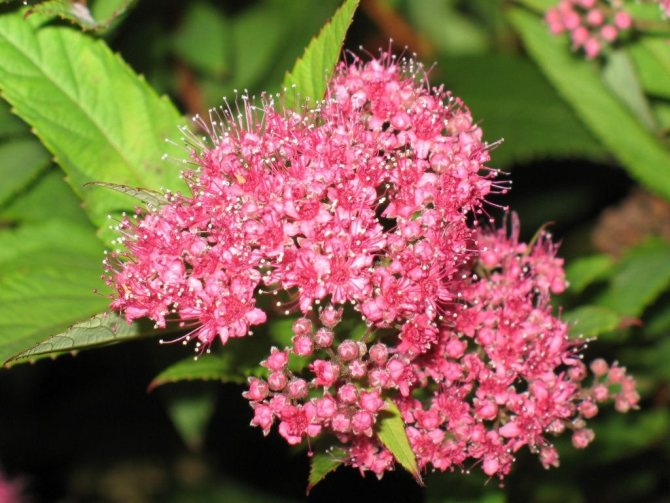

Meadowsweet and some other species have a horizontal rhizome. In the spring, young shoots appear next to the bush. They are dug up and transplanted to a new place. The adaptation of the seedling is quick and easy. Flowers will appear soon.
You can propagate meadowsweet by layering. To do this, in the spring, the lower branch is buried in earth. By the end of summer, roots are formed on it. The shoot is cut off and planted separately.
Medicinal plant - meadowsweet: useful and medicinal properties and contraindications
Due to its chemical composition, the honey cake is widely used in medicine. Namely, this plant contains:
- Ascorbic acid, salicylic acid
- Lots of vitamins, including vitamin C
- Essential oils, tannins
- Carotene, rutin, astringents, catechins
- Wax, fat, terpene.
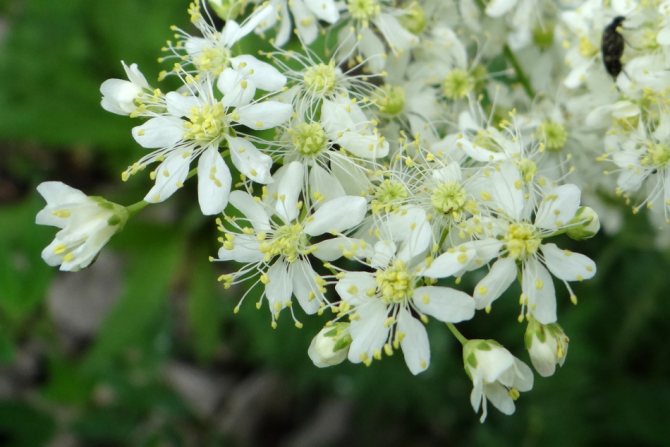

Indications for the use of meadowsweet
Herbalists recommend elm grass for treatment:
- Migraine... The amazing ability of meadowsweet to cool and promote blood circulation helps to cope with severe headaches.
- Stomach ulcers... The drug is used as an adjuvant in the treatment of this disease. It is better to use it with chamomile, plantain, marshmallow.
- Heartburn, gastritis, acidity... The astringent properties of the honey cake help to envelop the walls of the stomach.In addition, meadowsweet can relieve pain and kill germs.
- Diarrhea... Even children will love the pleasant taste of the brewed herb. With the help of such a natural healer, you will get rid of diarrhea and discomfort in the abdomen.
- Rheumatism... The herb is effective for joint pain as it has anti-inflammatory properties.
- Conjunctivitis... A warm decoction of the leaves has a beneficial effect on this infection.
- Dysplasia of the cervix... Tavolga for this disease is used in combination with other drugs.
- Diabetes... An extract of meadowsweet herb is added to the composition of medicines to treat this disease.
- Fevers with ARVI... If you use complex therapy with meadowsweet and yarrow, then the fever will pass in a short time.
- Gout... For the treatment of this ailment, it is better to use tea from the leaves of the herb, in addition, such tea is an excellent diuretic.
- Dysentery, pneumonia, diphtheria... Meadowsweet contains substances that cope with the microorganisms that cause these infections.
- Burns... Minor burns can be treated with an ointment made with the addition of meadowsweet.


Contraindications for the use of meadowsweet
Contraindications:
- Allergic reactions to aspirin
- Bronchial asthma
- Constipation
- Poor coagulability, thrombocytopathy
- Children and adolescents under 12 years old
- You can not take meadowsweet for influenza and chickenpox
- Take with caution if blood pressure is low (hypotension).
Diseases and pests
Meadowsweet is resistant to diseases and pests.
Species specimens can occasionally be affected by powdery mildew, rust. For decorative varieties, ramulariasis is a rare case (leaf plates are covered with greenish spots that dry out over time). Treat with a fungicidal agent (for example, "Fundazol").
Among the pests, aphids and aphids should be noted. Treatment with an insecticide will help get rid of them. To combat aphids, you can use wood ash, spraying with an infusion of onions or garlic.
Tavolga - recipes for use in traditional medicine
For the preparation of infusions, ointments, tea, lotions, leaves, roots and flowers of meadowsweet are used.
- To get rid of stomach pain, prepare the tincture. Take 50 g of plant flowers, pour 1 liter of vodka and add 20 g of sugar to the container. Leave to infuse in a dark place for 12-14 days. Take 30 drops before meals 2-3 times a day.
- Pour 2 tsp into an enamel bowl. panacea roots, pour a cup of boiling water. Leave the tea in another container of boiling water for 34 minutes. When the tea has cooled down, drink 1/4 cup three times a day before eating. This drug is effective for bleeding, possesses anticonvulsant, calming action. Heals tumors of various etiology.
- For diarrhea treatment do the following: 1 tbsp. pour a cup of boiling water over meadowsweet tubers. Send it to a water bath for 10 minutes. Then let stand for 2-3 hours. Drink a tablespoon on an empty stomach 4 times a day.
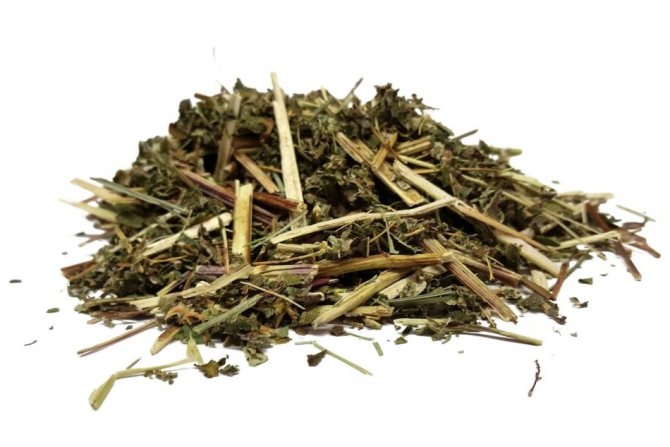

How to prepare tincture, decoction, ointment from meadowsweet for the treatment of various ailments?
Planting and leaving
Meadowsweet grows well in shaded, humid corners of the garden. But in a too dark place, he will be uncomfortable. It is better to plant the plant in a place where direct sunlight hits the branches in the morning and evening. The meadowsweet needs light, fertile soil with a neutral or slightly acidic reaction. Wood ash or chalk is preliminarily introduced into too acidic soil. The optimal soil mix consists of sod and leafy soil, peat and sand. Broken red brick is additionally added to heavy soils.
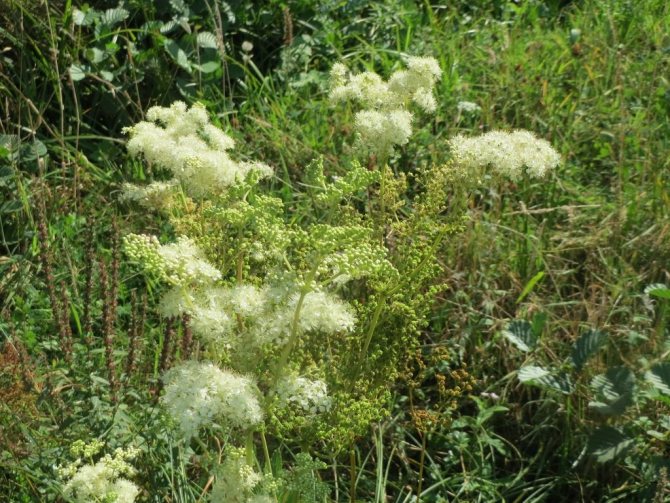

Before planting, the earth is dug up with nitrogen fertilizers. Meadowsweet is planted in the garden in early spring or autumn. It is best to do this in cloudy and rainy weather. When planting, the root collar should be at ground level. The optimum distance between plants is 30-40 cm. The soil is tamped and mulched to a height of 7 cm with peat.
Watering meadowsweet needs to be often, since its roots are located close to the surface of the earth. Excess liquid should be quickly absorbed into the soil. After watering, the soil is loosened so that air flows to the roots.
Several times a season meadowsweet is fed with complex mineral compositions for flowering plants. In the summer, add a solution of mullein and superphosphate.
Over time, the bushes grow strongly and lose their shape, so they are regularly trimmed. Pruning stimulates more lush flowering. Manipulations are carried out in the spring, and again at the end of summer. Every 7-14 years, lignified, bare shoots are cut to the ground, thereby rejuvenating. Young shoots soon appear from the stumps, forming a spherical growth.
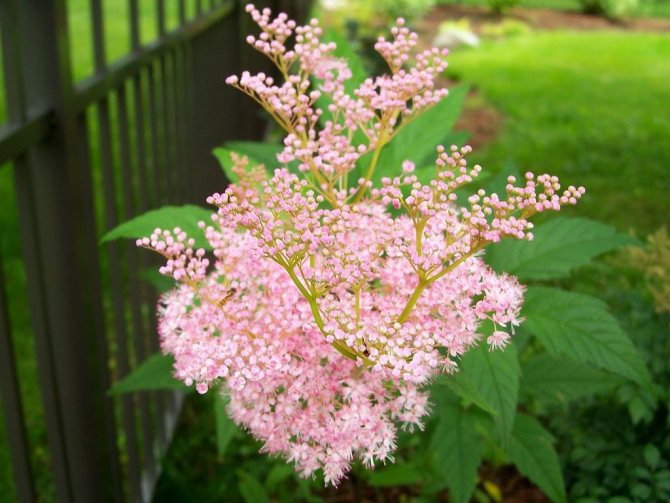

Spirea has strong immunity and resistance to parasites. In very rare cases, it is attacked by spider mites and aphids. Spraying with "Karbofos", "Pyrimor" or other chemical insecticide helps from pests.
Ivan tea with meadowsweet: useful properties, how to brew
This combined fee is taken for treatment, prevention:
- diseases of the nervous system
- diabetes
- gastrointestinal diseases
- swelling
Plus, tea is effective if you have thick blood. Daily use of a panacea helps to liquefy it.
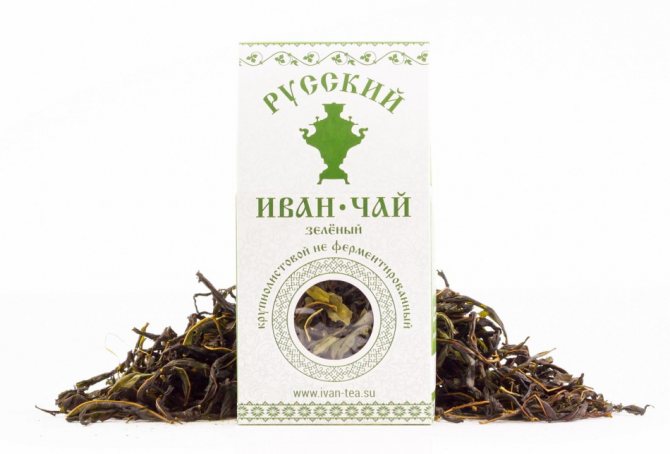

How to brew Ivan-tea with meadowsweet correctly?
Recipe:
Ingredients:
- Chopped flowers, leaves, meadowsweet stalks - 1 tsp.
- Ivan tea - 1 tsp
- Water - 550 ml
Preparation:
- Take a thermos, rinse with boiling water
- Pour in bulk components
- Pour in hot boiling water
- Close the thermos
- The drink should be infused for 30 minutes.
IMPORTANT: After using the first portion, you can brew the tea three more times. From this property it will not change.
Types and varieties of meadowsweet with photos and names
There are 10 species of meadowsweet (meadowsweet), most of them are grown in the gardens, varieties are also bred.
Common meadowsweet Filipendula vulgaris or six-petal Filipendula hexapetala


Common meadowsweet Filipendula vulgaris or six-petal Filipendula hexapetala photo
The height of the plant is about 80 cm. The leaf plates are pinnate - they resemble fern frond. In June, loose paniculate inflorescences appear, consisting of creamy white flowers. flowering lasts about 1 month. In the natural environment, it occurs along forest edges and meadows, which determines drought resistance, the ability to grow under bright sunlight.
Varieties:
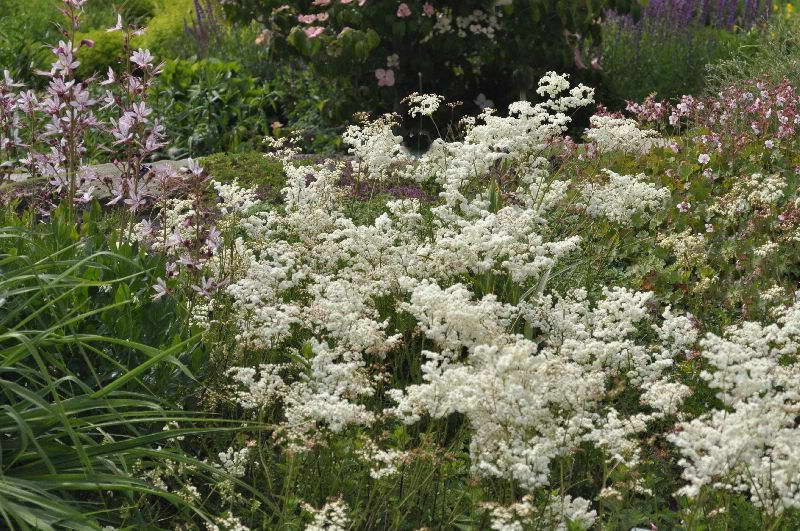

Common meadowsweet Captivity Filipendula vulgaris Plena photo
- Pleno - the height of the bush is 40-50 cm. Flowers are double, cream-colored.
- Grandiflora - limited to a height of 40-60 cm. Large-flowered variety (corolla diameter up to 1 cm), cream inflorescence shade.
- Flore Pleno - reaches a height of 40 cm, flowers are snow-white, double.
Elm-leaved meadowsweet Filipendula ulmaria
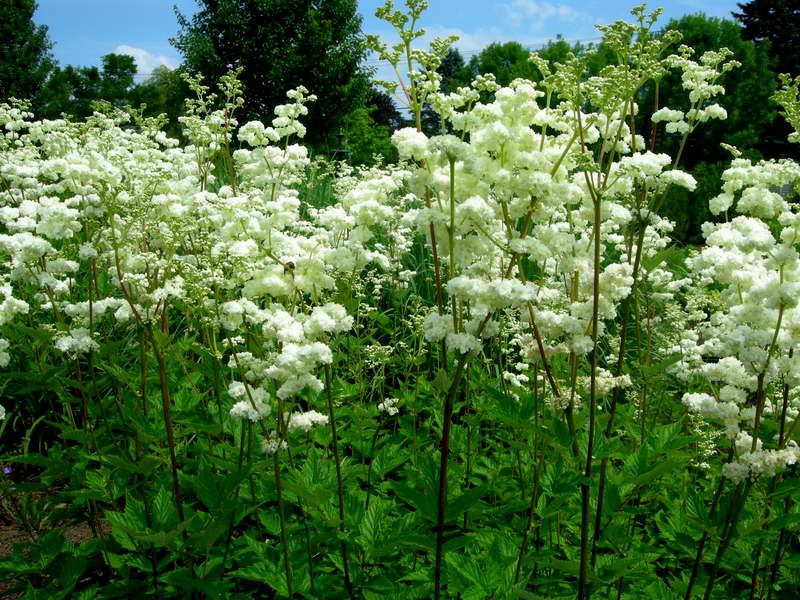

Elm-leaved meadowsweet meadowsweet photo Filipendula ulmaria 'Flore Pleno'
A very popular species in gardening. The natural habitat is the banks of rivers, streams, wetlands, damp ravines. Provide similar conditions. Loose bushes can reach a height of 1.5 m. During flowering, they fill the garden with freshness and honey aroma. Creamy flowers bloom in the second half of June, delighting about 25-30 days. Re-flowering is possible in August.
The meadowsweet feels good, both in a sunny area and in shade. Moisture-loving, frost-resistant. Can weed on the site, quickly mastering the adjacent space. Grow near water bodies, looks great in a flat rockery, undoubtedly appropriate in a flowerbed among other flowering plants.
Popular garden forms:
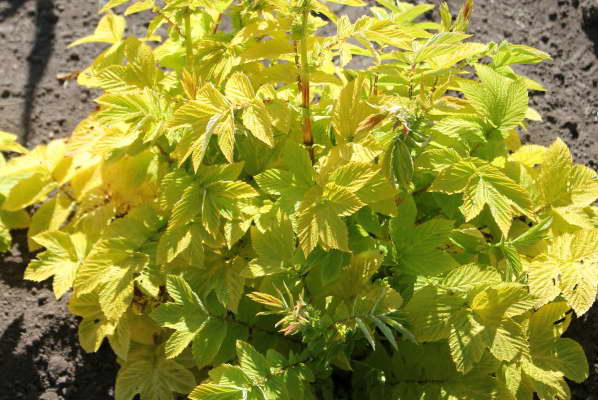

Meadowsweet Aurea Filipendula ulmaria ‘Aurea’ photo
- Flore Pleno - white, terry inflorescences.
- Rosea - has beautiful pink flowers.
- Aurea is a variegated form (leaves are covered with spots and stripes of a creamy yellow hue). The bush is compact, up to half a meter high.
Kamchatka meadowsweet Filipendula camtschatica or shelomaynik
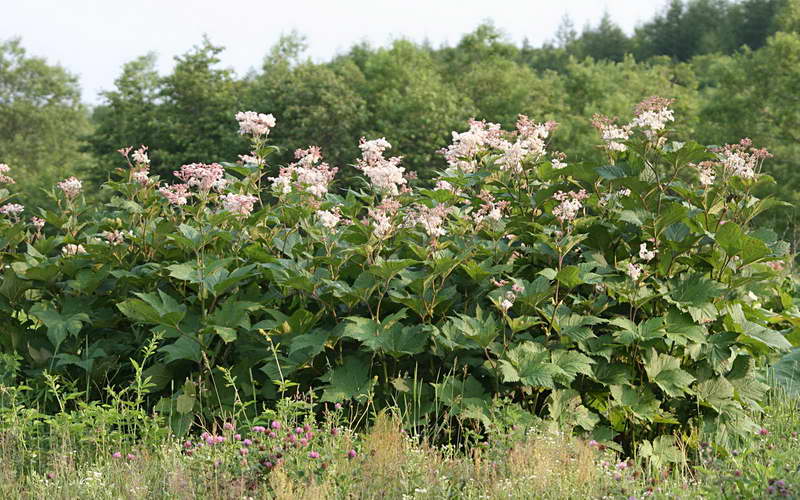

Kamchatka meadowsweet Filipendula camtschatica or shelomainik photo
Endemic (has a limited habitat - found only in Kamchatka). In their natural habitat, they form large thickets in which bears rest. The height of the bush reaches 3 m, the leaf plates grow up to 30 cm long. Bears are happy to eat young juicy shoots and leaves. All parts of the plant are edible for humans. Flowering occurs in July. Inflorescences are snow-white. Growing site: sunny or slightly shaded wet area.
Filipendula palmata


Meadowsweet Filipendula palmata photo
Unlike other species, it has long underground rhizomes. Originally from the Far East. The height of the plant is slightly more than 1 m. The basal leaves are cordate, attached on long petioles, the wrong side of a lighter shade, pubescent. Stem leaves are palmate. Snow-white inflorescences bloom in late June-early July, the panicle reaches a length of 25 cm.
The species is hygrophilous. Plant near water bodies, looks great against the background of the lawn.
Red meadowsweet or red meadowsweet Filipendula rubra
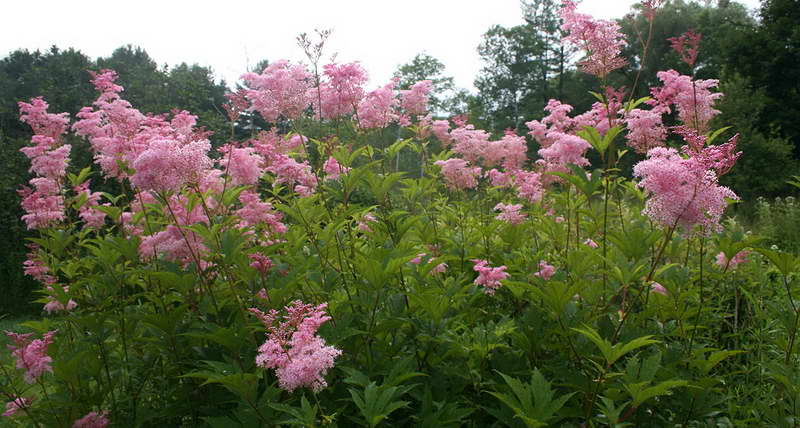

Red meadowsweet Filipendula rubra "Venusta" photo
A very viable species native to North America. In the natural environment, it reaches a height of 2.5, on the site it grows up to 1.5 m. Abundant flowering occurs in July-August. Inflorescences are large, red-pink. After flowering, crimson fruits appear - the impression of flowering continuity is created. They are used to compose winter bouquets.
Characteristics of the plant for cultivation: light and moisture-loving, frost-resistant (without shelter, it tolerates a drop in temperature to -35 ° C). The easiest way to reproduce is to separate the rhizome with growth buds. Even if you leave the folded plants left after weeding, they are able to release shoots. It will be necessary to limit the growth of red meadowsweet, since it is able to drown out other crops.


Meadowsweet Red Umbrella Filipendula Red Umbrella photo
Better to plant in small groups - single plants are more vulnerable to strong gusts of wind.
A garden form of Albo-captivity is grown, which has terry inflorescences of a frame shade, atypical for the species.
Red meadowsweet varieties:
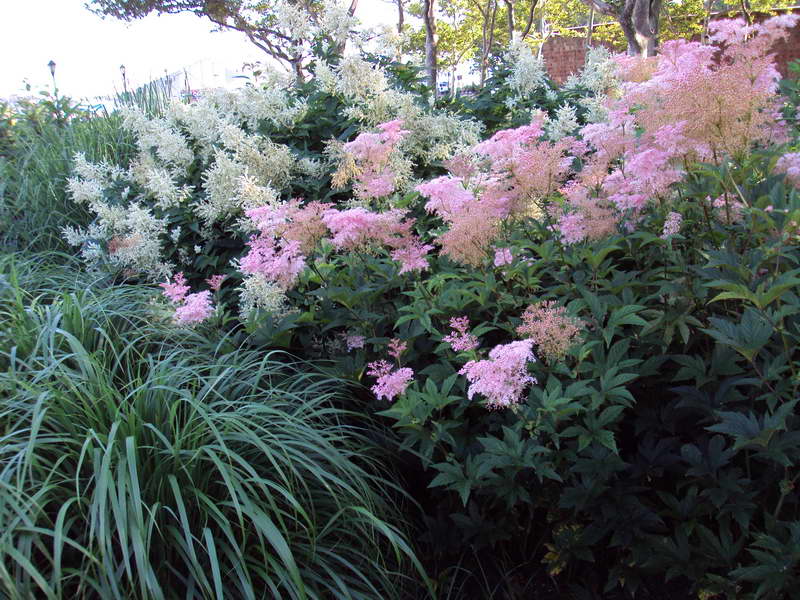

Red meadowsweet Filipendula rubra 'Venusta' photo
- Magnifica - inflorescences of a dark pink hue.
- Venusta - has large bright red inflorescences.
- Pygmy is a low-growing variety, reaching a height of 30 cm.
Purple meadowsweet or purple meadowsweet Filipendula purpurea


Purple meadowsweet Filipendula purpurea ‘Elegans’ photo
Originally from Japan, it is still rare in our gardens. Flowering starts in the first half of summer. The color is dark pink (purple).
Garden forms:
- Nana is a compact bush with a height of about 30 cm, inflorescences of a pink hue.
- Elegance - has modified stamens, flowers are red.
Meadowsweet in the treatment of kidney stones: a recipe
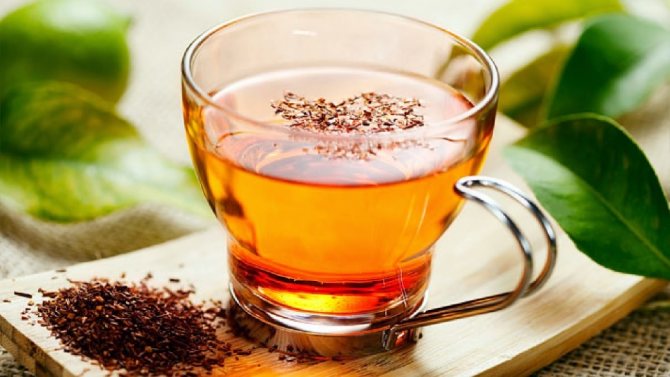

Treatment of kidney stones with meadowsweet
Recipe:
Ingredients:
- Meadowsweet flowers - 2 tsp
- Water - 0.2 l
Preparation:
- Pour in 2 tsp. dried, crushed flowers in a thermos
- Pour boiling water over the container
- Close the thermos
- After four hours, the tea is ready to drink.
- Drinking is divided into four doses and drunk before meals.
Nutritional value and chemical composition
Vase-leaved meadowsweet contains:
- ascorbic acid;
- traces of coumarins;
- phenol glycosides;
- phenolic compounds;
- tannins (6-23.7%);
- chalcones;
- flavonoids.


The aboveground part of the shrub contains:
- phenolcarboxylic acid (ellagic and caffeic);
- essential oil (in flowers 0.2%);
- catechins;
- aromatic compounds (methyl salicylate, vanillin, salicylic aldehyde);
- steroids;
- higher fatty acids;
- camphor.
Antiviral tincture on calendula vodka with meadowsweet: application
If you take antiviral tincture of calendula and meadowsweet every day, then no viruses are afraid of you.


Tincture of calendula and meadowsweet
Recipe:
Ingredients:
- Dried meadowsweet flowers
- Yarrow tincture - 5 ml
- Water - 200 ml
Preparation:
- Pour meadowsweet flowers into a cup so that it is half full.
- Pour lukewarm boiled water there. Leave this drug to infuse under the lid for 12 hours.
- Add 50 ml of pharmacy calendula tincture to your drink.
- After 3-4 hours, strain the infusion and gently squeeze out the flowers.
- A panacea should be drunk daily during epidemics, three times a day (1/2 tsp).
Description of the plant
Meadowsweet is a perennial deciduous plant in the form of tall grasses or dwarf shrubs. Shoot height is 15-80 cm. Some varieties can grow up to 2-2.5 m. Thin, erect twigs are covered with smooth brown bark. Shoots of some varieties spread along the ground. On old processes, the bark exfoliates in longitudinal plates.
The alternate leaves on long petioles are colored gray-green. They are lanceolate, lobed or rounded. Felt pubescence is often present on the reverse side.
By the end of June on the tops of the shoots, and sometimes along their entire length, dense paniculate or corymbose inflorescences bloom. They consist of many small flowers, white, cream or pink in color. The diameter of the inflorescence is about 15 cm. A single corolla does not exceed 1 cm in diameter. It consists of 5 petals, an ovary and a bunch of long stamens. It is thanks to the stamens that the inflorescences look fluffy.
The complex aroma of meadowsweet includes notes of vanilla, almond, honey and a slight bitterness. Flowering lasts 1-1.5 months and can come again at the end of summer. After pollination, the fruits ripen - leaflets with several seeds of a dark brown, almost black color. The seed length is 1–2 mm.
Oil, ointment, balm meadowsweet: application
In this form, elm grass is used to treat burns, inflammations, skin wounds and to relieve rheumatic pains. And of course, balms are used for cosmetic purposes.
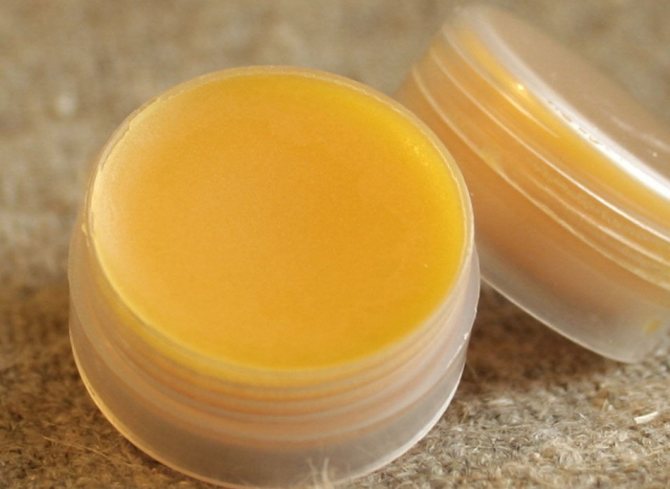

Balm with meadowsweet
- For making butter take fresh meadowsweet flowers, place in a jar. Butter hold it in a boiling water bath for 40 minutes in advance. When it gets cold fill it with meadowsweet flowers, close the jar with a tight lid. The mixture should stand in a dark, dry place month and a half... On the for ten days wooden spoon stir the composition once a day... The rest of the period, do not touch the drug. As a result, you just have to strain the oil. And you will receive a fragrant remedy for medical and cosmetic procedures on the skin.
- To obtain ointment buy at the pharmacy petrolatum or lanolin... Thoroughly chop the meadowsweet rootsto make a powder. Mix with petroleum jelly. Apply as needed for joint pain... Ointment is recommended rub three to four times a day.
- Balm make of wax (20 mg) and meadowsweet oil (25 mg)... at first wax crushed and placed in a container. Then his melt in a water bath. Add oil, stir and poured into a mold... Leave the mass in the refrigerator until it solidifies completely. Then it can be applied.
Choosing a site for planting meadowsweet
Meadowsweet is photophilous, but the scorching rays of the sun can do harm. Choose a slightly shaded area or a place where the sun will not enter at midday. It may not bloom in full shade.
Light, moisture-consuming soils with good drainage are best suited. Grow in neutral neutral garden soil. Dilute heavy clay soil with sand. If the soil reaction is acidic, it must be neutralized (add ash or garden lime). Introduce compost or humus into the depleted one for digging.
The use of meadowsweet for diabetes
To lower blood sugar, you should drink a panacea for a month, then take a 10-day break and repeat again. Drink tea just before meals three times a day.
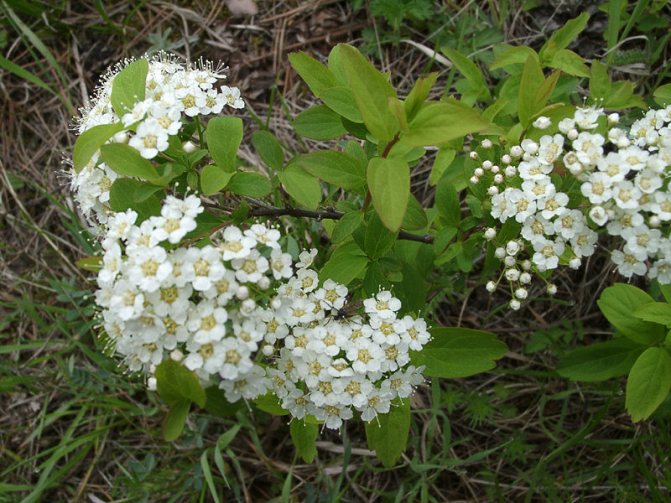

Meadowsweet for diabetes
Recipe:
Ingredients:
- Dried meadowsweet flowers - 1 tbsp
- Water - 1 l
Preparation:
- Pour flowers into one container and pour boiling water
- And in another, heat the resulting composition in a water bath for 15-23 minutes
- Drink 1/3 cup at a time
Meadowsweet in landscape design


Tavolga on a personal plot
Meadowsweet or meadowsweet is used in solo and group plantings.
Airy inflorescences of unobtrusive shades can "dilute" an overly bright flower bed. Can be placed in the center of a flower garden, surrounded by low-growing flowers. A group landing in the background gives the impression of a white or pinkish haze.
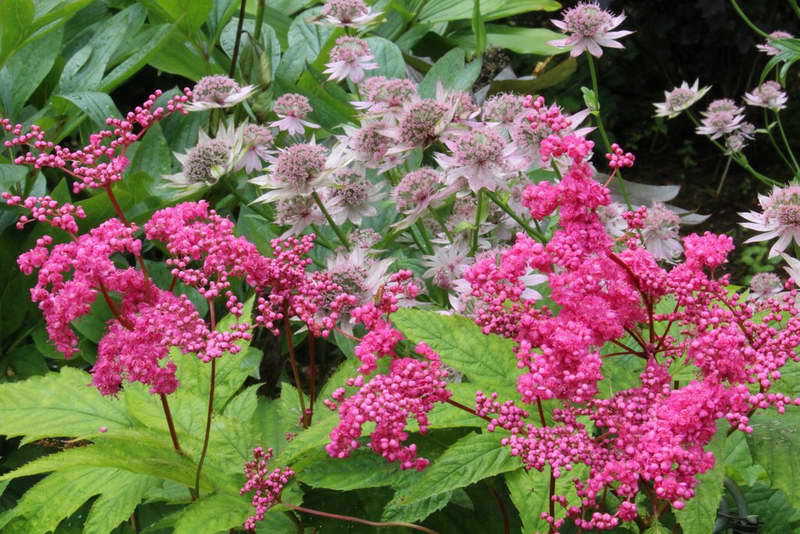

Tavolga and astrantia on a flower bed photo
Tall varieties are used to create a hedge, zoning a site (you can separate a sandbox, a gazebo). Low-growing ones are good in border plantings, for framing flower beds.
Combine different varieties of meadowsweet. Plant in mixborders.
Plant around the perimeter of a fence or at home, arrange a garden path - touching inflorescences look elegant and solemn.
Suitable partners: ferns, lilies, astilba, irises, Caucasian scabiosa, carnations, peonies, spotted loosestrife. You can create a scenic fence in a duet with hydrangea. It goes well with marigolds, various host varieties.
Due to the moisture-loving meadowsweet, it is used to frame artificial ponds. A spectacle of incredible beauty: a weightless blooming cloud is reflected in the water surface.
How to use meadowsweet extract for aging facial skin?
So that your skin regains its former elasticity and becomes radiant and youthful again. Use an ointment with meadowsweet oil topically and a decoction with the leaves of this plant inside. It is enough to apply the ointment only once a day in the evening. And you should drink the drug in the morning before eating.


Application of meadowsweet for face skin
IMPORTANT: Before using a medicinal plant, be sure to read the contraindications.
What diseases does it treat
Meadowsweet helps with colds, flu, coughs and even asthma. Medicinal products based on meadowsweet have an effective effect on diseases:
- Neuralgic;
- Dysentery;
- Hemorrhoids
- Bronchitis and pneumonia;
- Sore throat and runny nose;
- Liver disease;
- Diabetes
- Arthritis;
- Inflammation of the trigeminal nerve ending;
- Epileptic seizures;
- Heart disease;
- Clogged veins and blood clots;
- Cancer neoplasms;
- With parasites;
- Abscesses and psoriasis;
- Diaper rash;
- Insect and snake bites.
Contraindications and possible harm
Tavolga, like all medicinal plants, has contraindications for use. If the instructions for use are not followed, it can be harmful. Drugs and preparations from the plant are contraindicated for people with high blood pressure, its use is possible only in small doses and only after a doctor's prescription.
May cause constipation, colic and nausea. Therefore, it is not advised to use it for people suffering from such problems.
It is not advisable to use meadowsweet in case of individual intolerance and allergies.
Contraindications
Due to its strong astringent properties, doctors consider chronic constipation as contraindications for meadowsweet, because taking it will only aggravate the situation. This herb helps to reduce blood pressure, so hypotensive patients should not be treated with it either. The same applies to poor blood clotting, thrombocytopathy and plant hypersensitivity. The meadowsweet has a number of other contraindications:
- The herb is poisonous with low toxicity, so it must be used with caution. Pregnancy is a strict contraindication for the treatment of meadowsweet.
- Although meadowsweet is effective in treating gastritis, plants cannot be used with an exacerbation of this disease.The same goes for stomach or duodenal ulcers. Before taking, a doctor's consultation is required.
- When treating a cold, it is worth limiting the use of meadowsweet just before going outside, especially in winter. Due to the diaphoretic action of the plant, a remedy based on it can lead to hypothermia and deterioration of the condition.
Safe treatment rules
Treatment with meadowsweet requires some caution, because despite the low toxicity of the plant, it belongs to the list of potentially poisonous ones. The harm of meadowsweet and visleaf can occur due to the side effects that it causes:
- strengthens the stool - it is undesirable to take the meadowsweet preparations for people suffering from chronic constipation;
- reduces blood pressure - with a tendency to hypotension, it is worth abandoning treatment with meadowsweet;
- increases bleeding - with thrombocytopenia or coagulation disorders, meadowsweet becomes an additional provocateur of bleeding;
- causes allergies - hypersensitivity reactions can occur in people prone to allergies.
Contraindications for meadowsweet include age up to 12 years, pregnancy, lactation. All this is due to the unproven safety of the plant for these categories of the population.
According to patient reviews, if the recommended doses are observed, meadowsweet preparations are well tolerated. At the same time, the multifaceted medicinal properties of meadowsweet allow the plant to be used for the treatment of many diseases. But it is important to understand that taking the plant is not a panacea and does not exclude the need for drug treatment. And in the presence of chronic diseases, the intake of meadowsweet preparations should be coordinated with the attending physician.
Application forms
Various water-based medicines and alcohol-containing preparations are prepared on the basis of meadowsweet. They can be purchased at pharmacies or prepared at home from dry plant materials. Consider the main forms of application of funds based on meadowsweet.
Tea
Meadowsweet tea is brewed from grass or plant inflorescences. This drink has anti-inflammatory and diuretic effects. It is widely used to treat diseases of the genitourinary system and gastrointestinal tract. With regular use, tea from meadowsweet has a tonic effect.
Decoction
A decoction of meadowsweet is prepared from the roots and herbs of the plant. The agent is used orally for the treatment of oncology, disorders of the cardiovascular system, intestinal disorders and diseases of the genitourinary system. The broth is used externally for douching in gynecology and for disinfection of wounds and abrasions.
Infusion
An infusion of meadowsweet lowers blood sugar, normalizes sleep and has anesthetic and anti-inflammatory effects in diseases of the liver, kidneys and genitourinary system. The tool is widely used in gynecology for the treatment of thrush, irregular menstrual cycle, mastopathy, cervical erosion and infertility.
Tincture
Tincture of the plant has anticonvulsant and sedative effects. It is prescribed for disorders of the heart and central nervous system. The tool has a high regenerating activity, therefore it is used to heal ulcers, cracks and erosions of the stomach.
Meadowsweet tincture is used externally for rubbing and compresses for rheumatism, gout, arthrosis and osteochondrosis. With its help, long-term non-healing wounds and trophic ulcers are treated.
Ointment
Ointment from meadowsweet is used externally for the treatment of joint diseases and skin diseases. The tool effectively relieves pain and inflammation in rheumatism, arthrosis and osteochondrosis. To prepare the drug, the powdered roots of the plant are mixed with butter, petroleum jelly or lanolin in a ratio of 20 grams. dry raw materials for 90 ml of liquid.
Butter
From the flowers of the plant, by means of distillation, meadowsweet oil is obtained.This remedy is used externally for the treatment of damaged skin areas and the treatment of joint diseases. It is widely used in aromatherapy to treat disorders of the nervous system.
The use of meadowsweet oil lies in the high concentration of biologically active substances. Thanks to this, the agent has a pronounced soothing, antispasmodic, antiseptic and anti-inflammatory effect.
Using seeds and flowers
In the cold season, it is important how the prevention of colds is carried out. For preventive purposes, meadowsweet inflorescences are used in infusion.
Meadowsweet flowers strengthen the immune system, have an antimicrobial effect, therefore they are successfully used in the prevention of influenza, acute respiratory infections.
The infusion of flowers is prepared as follows. Fill a jar (500 ml) tightly with flowers to half the volume, fill with cold water, stand for 12 hours. To preserve the infusion, add 25 g of calendula tincture (pharmacy). Add to tea, fruit drink, compote.
Ointment for psoriasis: mix 10 g of crushed flowers well with 40 g of petroleum jelly, rub into problem areas.
Tincture of meadowsweet seeds after a stroke: soak 100 g of vodka and 2 teaspoons of seeds without access to light for 10 days, take 2 teaspoons with meals.
Varieties
The Tavolga genus unites 16 species of herbaceous plants. The most common ones are:
- Meadowsweet (lat.Filipendula ulmaria);
- Kamchatka meadowsweet (lat.Filipendula camtschatica);
- Common meadowsweet (lat.Filipendula vulgaris);
- Narrow-lobed meadowsweet (lat.Filipendula angustiloba);
- Palm-shaped meadowsweet (lat.Filipendula palmata);
- Smooth meadowsweet (lat.Filipendula glaberrima).
For more information about meadowsweet, see the video:
Tea
Tea made from meadowsweet strengthens the immune system, is the prevention of diseases in the cold season, reduces pain in the stomach, relieves irritation:
- 2 tbsp. soak tablespoons of meadowsweet for no more than 15 minutes in a liter of boiling water, drink with honey during the day;
- a teaspoon of meadowsweet flowers brew for five minutes in 250 ml of boiling water.
Grass and meadowsweet flowers can be added to various teas (green and black, fireweed) and used as a preventive measure in the cold season in hot or warm form with the addition of honey.
Collection, drying, storage
The meadowsweet grows in Western Asia, the Caucasus, and Siberia. Therefore, we can say that the collection of medicinal raw materials can be carried out everywhere. Tavolga is a "regular" of marshlands, flood meadows and the banks of water bodies, floodplain forests.
That is, she loves shady areas and moist soils. "Tops" and "roots" (inflorescences and rhizomes) are of particular value. The collection of raw materials is carried out at different times: inflorescences - in June-July, rhizomes - in September-October.
Drying of raw materials is carried out in the shade and in a draft (in attics, in sheds and under sheds). The dried parts of the plant can be stored for up to two years - in cardboard boxes and canvas bags (provided that the correct temperature and humidity conditions are observed).
The soil
There are no requirements for the composition of the soil, it is only important that it is loose, rather moist and has a slightly acidic or neutral reaction to acid. It is also not desirable to create stagnation of irrigation water. Before planting a plant for a faster development of its root system, it needs to pour wood ash. And make supports for shoots that will begin to curl.
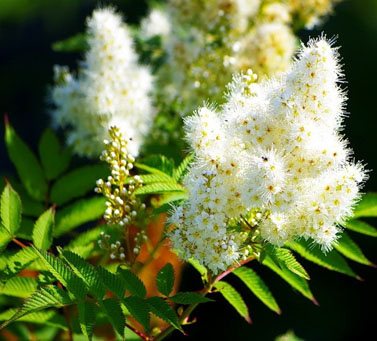

Marsh meadowsweet
Meadowsweet - the scent of newlyweds
It is also called as a newlywed wreath. The peculiarity of this flower is that the smell of the leaves is quite different from the flowers. The latter have an almond aroma, it is used for sprinkling floors in cells. Hinting at such a use, in ancient times they said: "The leaves and flowers of meadowsweet stand out from all other medicinal herbs, as they cover the floors of houses, in wards, and banquet halls in the summer, its smell fills the hearts and feelings of newlyweds with a joyful incense" ...
Summarizing the health benefits of meadowsweet, it is an aromatic herb with astringent properties that relieves pain.It is also worth noting that meadowsweet was one of the three most sacred herbs (among them mint, verbena) used by the ancient Celtic sacred druids.
FILIPENDULA ULMARIA (L.) MAXIM. - LABAZNIK (TAVOLGA) VYZOLIFY FILIPENDULA HEXAPETALA GILIB. - LABAZNIK (TAVOLGA) SIX-FEDERAL FAMILY ROSACEAE - ROSE-COLORED (Popular names: Marsh medunka, lungwort, whitehead, meadowsweet)


